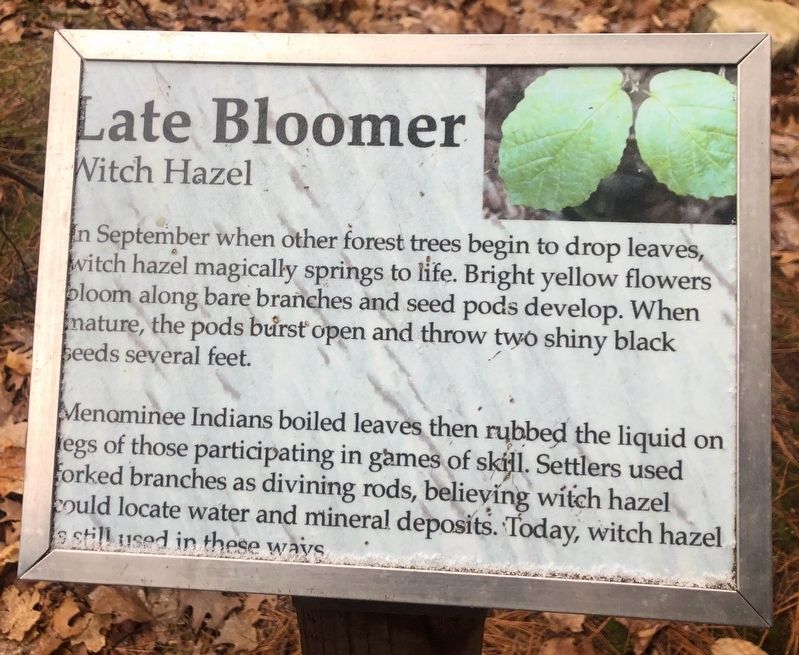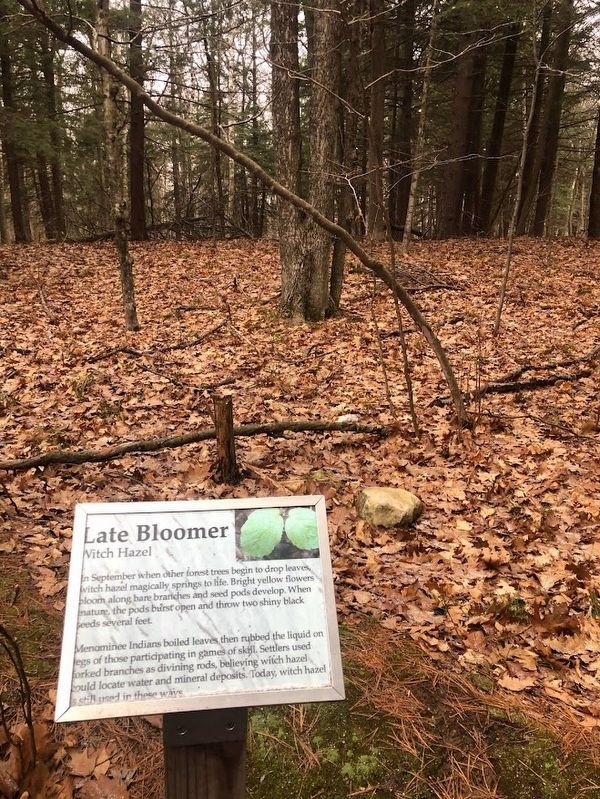Fish Creek in Door County, Wisconsin — The American Midwest (Great Lakes)
Late Bloomer
Witch Hazel
Menominee Indians boiled leaves then rubbed the liquid on legs of those participating in games of skill. Settlers used forked branches as divining rods, believing witch hazel could locate water and mineral deposits. Today, witch hazel is still used in these ways.
Topics. This historical marker is listed in these topic lists: Horticulture & Forestry • Native Americans • Parks & Recreational Areas • Settlements & Settlers.
Location. 45° 9.531′ N, 87° 12.078′ W. Marker is in Fish Creek, Wisconsin, in Door County. Marker can be reached from Shore Road. The marker can be found in Wisconsin's Peninsula State Park on the Sentinel Trail between Shore Road and Highland Road. It is a hike of about one-third of a mile from the Eagle Tower. Touch for map. Marker is in this post office area: Fish Creek WI 54212, United States of America. Touch for directions.
Other nearby markers. At least 8 other markers are within walking distance of this marker. Cold Cure (about 700 feet away, measured in a direct line); Growing a Forest (approx. 0.2 miles away); Albert E. Doolittle (approx. ¼ mile away); A State Park System is Formed (approx. ¼ mile away); A Tough Tree (approx. 0.3 miles away); Life on the Ledge (approx. 0.3 miles away); Shipwrecked! (approx. 0.3 miles away); Looking Back (approx. 0.3 miles away). Touch for a list and map of all markers in Fish Creek.
Also see . . . American Witchhazel (Hamamelis virginiana L.). From the U.S. Forest Service
Excerpt: American witchhazel posses some interesting lore and uses. The most interesting use as been the use of forked limbs as dowsing or divining rods. Early European settles observed Native Americans using American witchhazel to find underground sources of water. This activity is probably where the common name witchhazel came from. 'Wicke' is the Middle English for 'lively' and 'wych' is from the Anglo-Saxon word for 'bend.' American witchhazel was probably called a Wicke Hazel by early white settlers because the dowsing end of the forked branch would bend when underground water when detected by the dowser. This practice had a widespread use by American settlers and then exported back to Europe. Dowsing became an established feature of well-digging into the 20th century.(Submitted on January 1, 2024, by Sean Flynn of Oak Park, Illinois.)
Credits. This page was last revised on January 1, 2024. It was originally submitted on January 1, 2024, by Sean Flynn of Oak Park, Illinois. This page has been viewed 45 times since then. Photos: 1, 2. submitted on January 1, 2024, by Sean Flynn of Oak Park, Illinois. • J. Makali Bruton was the editor who published this page.

